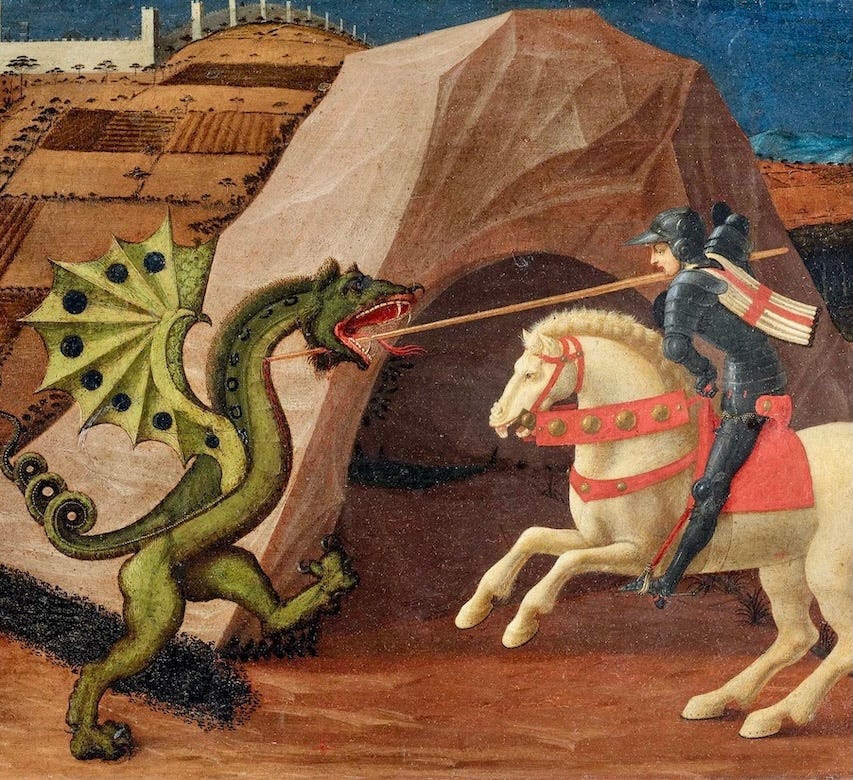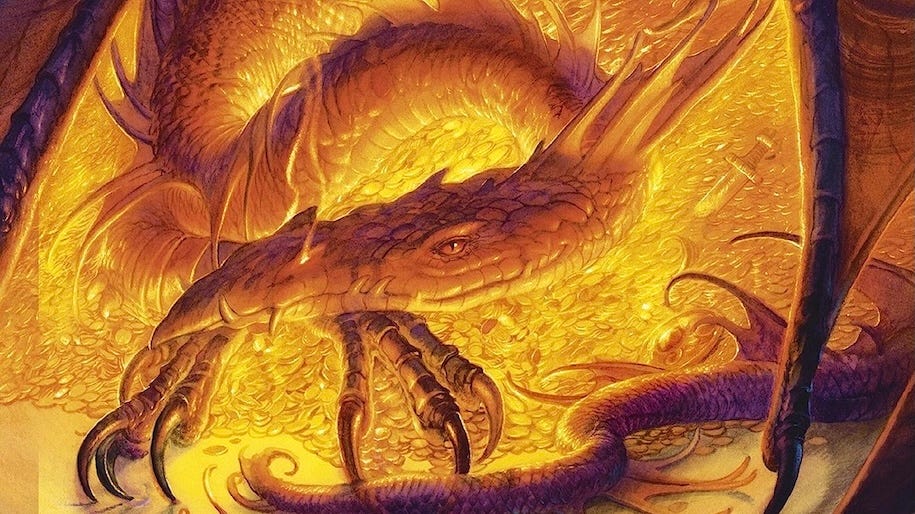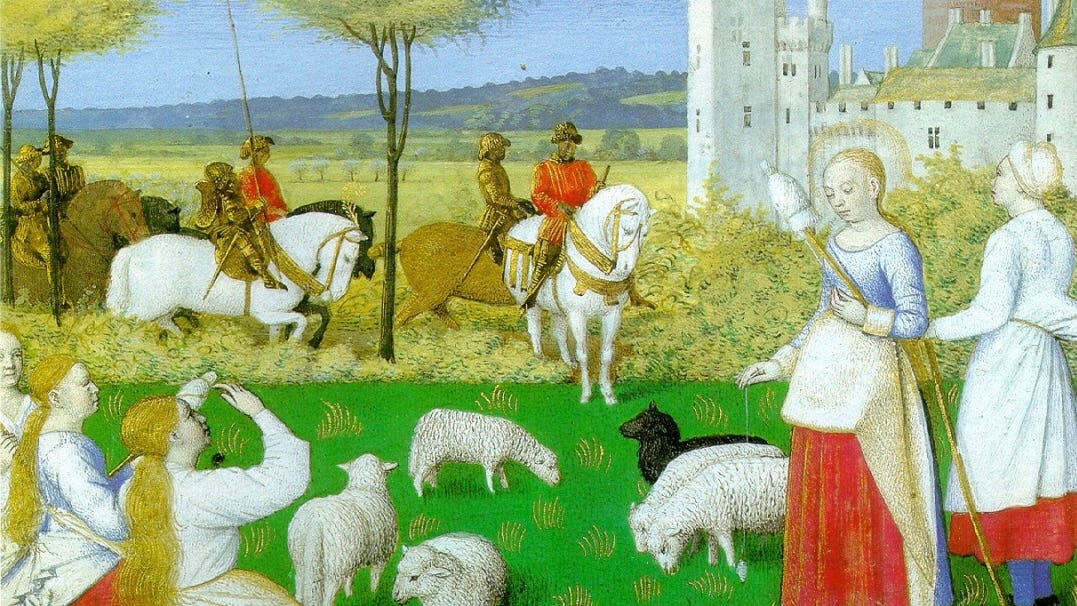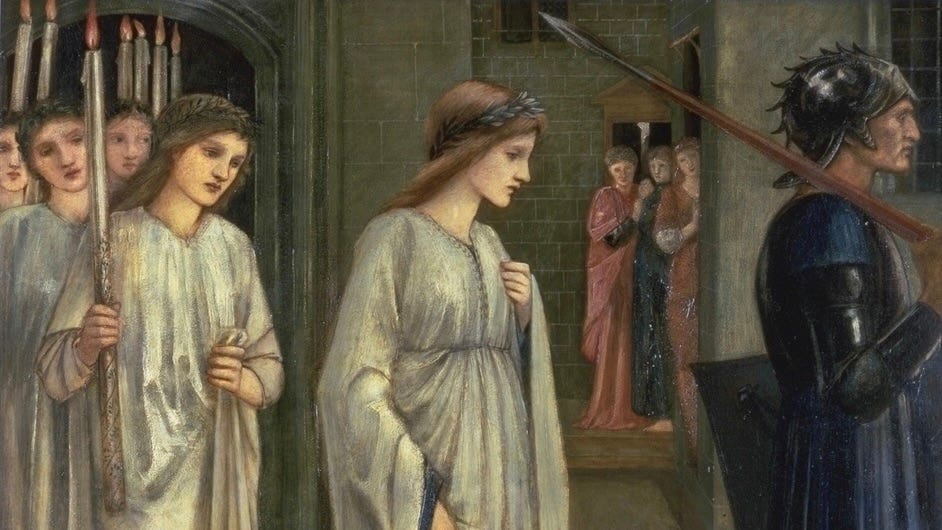How to Defeat Evil
St. George & how to slay dragons
What is the nature of evil, and how do you destroy it?
This question has been asked by every civilization since the dawn of time. In many ways, all societies can be judged by their ability to answer it — those which provide a clear answer last the longest, while those which struggle to respond disappear the fastest.
For a period of time, there was one story in particular that people turned to for help answering this question: the story of Saint George and the dragon. On the surface, it’s a simple story — a brave knight slays a dragon, saves a damsel, and converts a city to Christianity. The end.
Except, it’s not at all that simple. The reason the legend of Saint George has endured for well over 1,000 years is because it speaks to something eternal: not only does it reveal the true nature of evil, but it also shows how to destroy it.
The story of Saint George and the dragon has much to offer to anyone who seeks to fight for the sake of the good, true, and beautiful. That’s why today, we dive into this centuries-old tale to see what it can teach us about what evil is, and how to defeat it…
Reminder: this is a teaser of our members-only deep dives.
To support our mission and get our premium content every week, upgrade for a few dollars per month. You’ll get:
Full-length, deep-dive articles every weekend
The entire archive of great literature, art, and philosophy breakdowns
Members-only podcasts and exclusive interviews
The Nature of Evil, Pt. 1: Perversion
And by this city was a stagne or a pond like a sea, wherein was a dragon which envenomed all the country.
-William Caxton’s 1483 English translation of the Legenda sanctorum
The story of Saint George and the dragon begins, naturally, with a dragon. Because dragons are so often depicted in popular media, it’s easy to take them for granted today. But if you want to understand the nature of evil, you must pay attention to the details and symbolism.
The first thing to note about the dragon is that it is a perversion of something natural, something good. Lizards, snakes, and iguanas might make you uncomfortable, but they are natural in the sense that they are designed to be how they are. The dragon, however, is a perversion of nature. It is not an inanimate object or something artificial, but rather something that has its origin in nature. This is part of what makes evil so compelling, since if the dragon were clearly otherworldly, everyone would be opposed to it.
But by perverting nature, evil makes itself more tempting — you can see that the dragon, though a strange animal, is still an animal. You can see how it’s not that dissimilar from other animals you know. And because of this, you tolerate it. Perhaps you don’t let it into your city, but you let it mind its own business in the countryside…
The Nature of Evil, Pt. 2: Deception
The symbolism of the pond from which the dragon emerges reveals another key truth about evil. Unlike a river, a stream, or even a large lake, a pond has no natural currents to keep water flowing. While moving water remains clean and fresh, stagnant water breeds decay and death — in some cases, it literally kills fish due to the lack of oxygen.
All this is to say, evil emerges from festering and stagnant waters, those forgotten about and never tended to. The pond in the story of St. George isn’t located inside the city, where it would be tended to daily, but outside of it, further reinforcing this idea.
Things overlooked or forgotten, however, cannot be ignored forever:
And when [the dragon] came nigh the city, he venomed the people with his breath.
Here, the Golden Legend tells us that the dragon doesn’t begin his reign of terror by attacking people directly. Rather, it is his poisonous breath that kills people.
What this reveals is that mere proximity to evil is enough to cause harm — you might think you’re standing at a safe distance, but some of evil’s effects are invisible to the naked eye…
The Nature of Evil, Pt. 3: Destruction
In the story of Saint George, the dragon begins its reign of terror by bargaining with the people: in return for staying away from the city, he first demands sheep. Once the sheep run out, he’s given men. Finally, he demands the young children.
This, according to the Golden Legend, is evil’s greatest hallmark: it destroys not just the innocent, but innocence itself. The road to get there is filled with concessions and bargaining, as evil tells you that it will leave you alone if you give it what it wants. First that’s just some sheep, then it’s some strangers, but it’s nothing directly related to you.
Ultimately, however, evil always craves one thing: the destruction of innocence.
In this way, the behavior of the dragon is identical to that of the serpent in the garden of Eden. It is not without reason that the dragon wants to devour virgins, who represent the ideal of innocence and purity. And in this story, he almost gets away with it — until, that is, Saint George rushes onto the scene.
When the King’s virgin daughter is sent to be offered up in sacrifice to the dragon, Saint George finally arrives. What he says to the maiden, and how they team up to defeat the dragon, reveals everything you need to know about how to confront and destroy evil.
Strength and courage alone don’t slay dragons. Overcoming a great foe — whether a literal beast or a moral struggle in your own life — requires far more of you than that. Because true evil isn’t defeated how you think it is…
Keep reading with a 7-day free trial
Subscribe to The Culturist to keep reading this post and get 7 days of free access to the full post archives.







